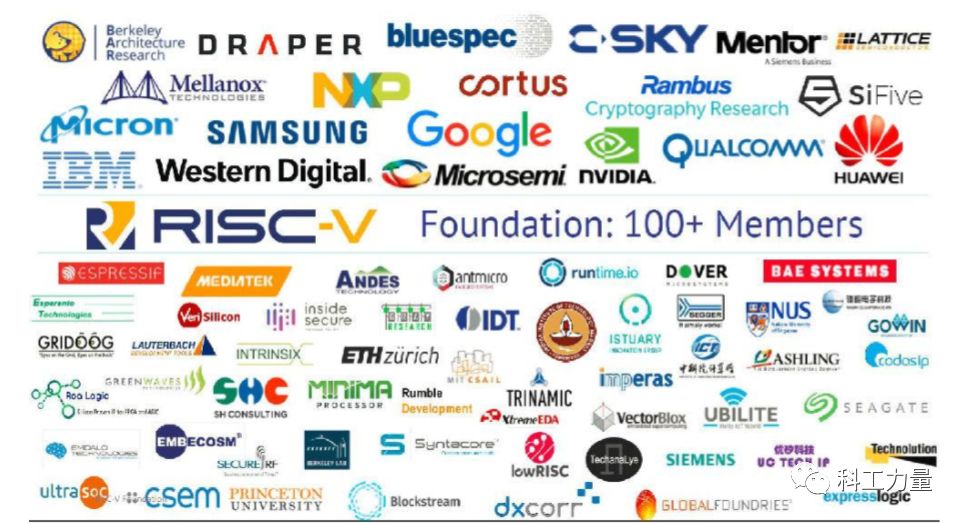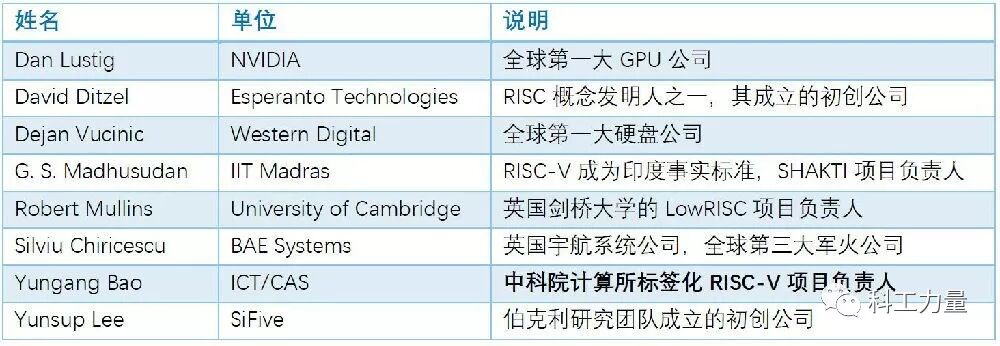In media reports, ARM mini China is set to IPO in mainland China. Following this, online discussions have linked this event with the development of RISC-V by the Berkeley research team in the United States, which has attracted over 100 technology companies including IBM, NXP, Western Digital, NVIDIA, Qualcomm, Samsung, Google, and Huawei to join the RISC-V camp. Some believe that the promotion of RISC-V by the United States is aimed at undermining ARM and ultimately achieving control over the global CPU market.
In reality, RISC-V is an academic open-source CPU and the participation of over 100 technology companies in the RISC-V camp is more based on commercial interests rather than any “conspiracy” or “grand strategy.” The biggest revelation RISC-V offers to China is that building an independent technology system apart from Wintel and AA is not as difficult as it seems.
What is RISC-V
RISC-V is pronounced as RISC Five, indicating the fifth generation of reduced instruction set computing. The name was chosen because Professor David Patterson from the Berkeley research team had previously developed four generations of RISC chips.
RISC-V is not a product of national will but rather a research project from the University of California, Berkeley. In 2010, the Berkeley research team aimed to design a CPU, but Intel’s licensing for x86 was very restrictive, and the licensing for ARM’s instruction set was extremely expensive. Moreover, the licensing for ARM 32 was also very strict, with only four companies like Apple and Qualcomm obtaining licenses. Domestic companies like Huawei and Spreadtrum only received ARM 64 licenses.
In 2010, MIPS had not yet been acquired by Imagination, SPARC had not yet been abandoned by Oracle, and IBM had not yet developed Open Power. This left the Berkeley research team with limited options, including DEC’s now-defunct Alpha, HP’s abandoned PA-RISC, and Itanium, which even Intel struggled to promote. Faced with this situation, the Berkeley research team boldly decided to design a completely new instruction set from scratch.
Many media reports describe defining a set of instruction sets as a black technology, but in fact, creating a high-performance CPU and building a software ecosystem around the instruction set is the real challenge. The difficulty of defining a set of instruction sets is not high; the Berkeley research team completed the development of the RISC-V instruction set in just three months with four members.

RISC-V Instruction Set
Due to a lack of personnel and funding, the Berkeley research team decided to open-source RISC-V, making it the Linux of CPUs. After gaining support from various parties, they subsequently developed several products.
Currently, the Berkeley research team has completed a sequential execution 64 bit processor core based on the RISC-V instruction set (codenamed Rocket ) and has conducted 12 tape-outs based on 45nm and 28nm processes. The Rocket chip operates at a frequency of 1GHz and has been shown to outperform the ARM Cortex-A5 by 10% in measured performance, with an area efficiency improvement of 49% and a dynamic power consumption per unit frequency that is only 43% of that of Cortex-A5. In the embedded field, Rocket is already competitive with ARM.
Over a hundred technology companies joining RISC-V has nothing to do with conspiracy theories
In media reports, the upcoming IPO of ARM mini China in mainland China has led to online speculation linking this event with RISC-V, suggesting that the promotion of RISC-V by the United States is aimed at undermining ARM and achieving control over the global CPU market. Meanwhile, the IPO of ARM mini China in mainland China is seen as a countermeasure from the Chinese side.
However, this is a complete misunderstanding stemming from the media’s lack of technical knowledge. The IPO of ARM mini China in mainland China is merely SoftBank’s way of letting mainland Chinese investors take over, and has nothing to do with any “grand strategy.” In contrast, the full acquisition of Imagination by a fund with Chinese background, with Dr. Li Liyou from the original Unisplendour Group as CEO, seems more like a “grand strategy.”

Companies and academic institutions joining RISC-V camp
Furthermore, the participation of over a hundred companies in the RISC-V camp has no relation to the media’s claims that the United States aims to undermine ARM and achieve technological monopoly. In fact, the media’s reasoning is flawed, and I would like to clarify the following:
The United States has no need to undermine ARM since most of ARM’s R&D centers are located in the United States and were originally designed by Americans, with core technologies in American hands. The FBI and CIA can visit ARM’s R&D centers at any time to retrieve core secrets. Even though ARM is currently owned by Japan’s SoftBank, considering the tens of thousands of American soldiers stationed in Japan and Japan’s historical subservience to the United States, ARM cannot escape American control.
It would not be difficult for the United States to undermine ARM; it would not require the creation of RISC-V. The U.S. government could easily stifle ARM by implementing various restrictive policies. For example, similar to the restrictions on China’s independent CPU, the U.S. could require TSMC, UMC, GlobalFoundries, Samsung, and SMIC to prohibit tape-outs for ARM. IC design companies in the ARM camp, such as Qualcomm, Apple, and Huawei, would find themselves in a situation similar to ZTE. Besides using policy measures, commercial support for x86 is also an option. The U.S. government could fully support x86 or any of MIPS, Alpha, SPARC, or Itanium without needing to create RISC-V.
Joining RISC-V camp is more about commercial factors
Over a hundred technology companies joining the RISC-V camp is primarily due to commercial reasons. Although many reports attribute ARM’s success to its openness, in reality, ARM is only open in its business model while being very restrictive in technology.
To date, the number of companies that have obtained ARM32 licenses can be counted on one hand, and while there are more ARM64 licenses, the licensing fees are exorbitant. A French startup, Greenwave, stated that if they were to use the ARM architecture, they would incur $15 million in licensing fees. Moreover, after the license expires, whether to continue licensing and the associated fees must be renegotiated.
While licensing fees in the hundreds of millions of RMB are not a concern for large companies like Qualcomm, Apple, and Huawei, they are an unbearable burden for startups.
In this situation, startups are likely to favor the free RISC-V. Additionally, technology giants like IBM, NXP, Western Digital, NVIDIA, Qualcomm, Samsung, Google, and Huawei have chosen to join RISC-V due to their dissatisfaction with ARM and the desire not to put all their eggs in one basket.
However, this does not guarantee that RISC-V will have a bright future, as many of these tech giants are still observing and are hesitant to fully commit. Furthermore, the completely open-source nature of RISC-V, which allows commercial companies to add instructions independently, could easily lead to fragmentation of RISC-V.
This fragmentation would make it difficult to form a unified ecosystem, and in the future, we may see RISC-V processors developed by Huawei, Qualcomm, and Google that, while all classified as RISC-V, cannot run the same software. Just as complete openness and strong leadership are contradictory, if this issue cannot be resolved, RISC-V may struggle to grow to a level where it can compete with x86 and ARM.
The greatest revelation of RISC-V is that building an independent technology system apart from Wintel and AA is not that difficult
RISC-V offers the greatest revelation to China: establishing an independent technology system apart from Wintel and AA is not as difficult as it seems.
In the past, domestic commercial companies and even some state-owned units believed that “designing a completely new instruction set from scratch is an insurmountable task,” but in reality, RISC-V grew from a three-month summer project.
The popularity of RISC-V also reflects a phenomenon where new technologies from abroad are often enthusiastically embraced, leading to a rush to work for foreign entities. Additionally, given the historical context of the past few decades where “foreign open-source projects lead to domestic independence,” it is likely that in the future, we will see more instances of foreign-designed CPUs being packaged as “independently controllable CPUs.”
In fact, in terms of open-source and free options, there are already domestic alternatives like Loongson’s GS232 and GS132, which are open-source and offer free IP licensing. In terms of ecosystem, since the application field is embedded, the requirements for the ecosystem are not high. Moreover, even a poorly performing MIPS ecosystem is still better than the nascent RISC-V.
The quality and practicality of technology should not be judged by how closely it follows the U.S. but rather by how closely it is connected to applications. This phenomenon of blindly embracing foreign technology is highly abnormal, stemming from insufficient promotion of domestic technologies and a blind admiration for foreign products.

The list of the program committee for the 7th RISC-V conference
Researcher Bao Yungang from the Institute of Computing Technology, Chinese Academy of Sciences, who was selected for the program committee of the 7th RISC-V conference, stated, “The promotion of Loongson’s open-source may still be too limited, as it is rarely seen in the media. If there had been (Loongson) open-source soft cores at that time, we might not have chosen RISC-V for our project. However, switching to a new instruction set and processor implementation now would incur significant human resource costs.”
In summary, RISC-V provides the greatest revelation to China: establishing an ecosystem based on a new instruction set is not as difficult as it seems. Some people always view the establishment of an independent technology system apart from Wintel and AA as an insurmountable task and mock Shenwei and Loongson as Don Quixote, which is merely an excuse for their own cowardice and incompetence.